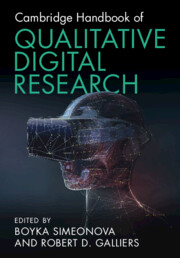Book contents
- Cambridge Handbook of Qualitative Digital Research
- Cambridge Handbook of Qualitative Digital Research
- Copyright page
- Contents
- Figures
- Tables
- Contributors
- Preface
- Part I Philosophical, Epistemological and Theoretical Considerations
- Part II Methodological Considerations
- Chapter 7 Human Values in a Digital-First World: The Implications for Qualitative Research
- Chapter 8 One Picture to Study One Thousand Words
- Chapter 9 Demystifying the Digital
- Chapter 10 Case Study Research Revisited
- Chapter 11 Social Media Qualitative Research Vignettes
- Chapter 12 Co-Inquiring in a Digital Age
- Part III Illustrative Examples and Emergent Issues
- Index
- References
Chapter 9 - Demystifying the Digital
A Case for Hybrid Ethnography in IS
from Part II - Methodological Considerations
Published online by Cambridge University Press: 08 June 2023
- Cambridge Handbook of Qualitative Digital Research
- Cambridge Handbook of Qualitative Digital Research
- Copyright page
- Contents
- Figures
- Tables
- Contributors
- Preface
- Part I Philosophical, Epistemological and Theoretical Considerations
- Part II Methodological Considerations
- Chapter 7 Human Values in a Digital-First World: The Implications for Qualitative Research
- Chapter 8 One Picture to Study One Thousand Words
- Chapter 9 Demystifying the Digital
- Chapter 10 Case Study Research Revisited
- Chapter 11 Social Media Qualitative Research Vignettes
- Chapter 12 Co-Inquiring in a Digital Age
- Part III Illustrative Examples and Emergent Issues
- Index
- References
Summary
An increasingly pervasive digital environment, where technologies mediate social interaction within and outside organizations, creates new rich data sources for IS research. Of primacy to IS scholars, who study phenomena at the intersection of technology, people and organization, is how future research designs can capture such ongoing sociotechnical entanglements occurring in hybrid online and offline spaces. Building on lessons learned from a study of platform workers, this chapter explores three key challenges of a hybrid ethnographic approach to IS research: (1) navigating unbounded fieldsites; (2) managing technological opacity; (3) working with diverse data. The chapter guides researchers by demonstrating how hybrid methods can be used in different configurations across diverse settings. Simultaneously, in the age of web crawlers, data scraping and machine learning, processes that are invaluable in their own rights, this chapter resituates a qualitative ethnographic approach to digital data, introducing participatory digital observation to the rich empirics gathered in face-to-face environments. Rather than reproducing the valuable work done by scholars in digital sociology and ethnography, this chapter brings strands of the conversation together, highlighting the benefits of studying IS phenomena as a hybrid that exists both in physical and virtual spaces.
Keywords
- Type
- Chapter
- Information
- Cambridge Handbook of Qualitative Digital Research , pp. 125 - 139Publisher: Cambridge University PressPrint publication year: 2023



